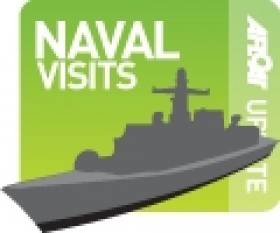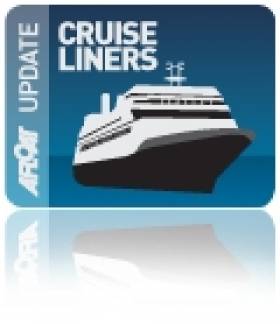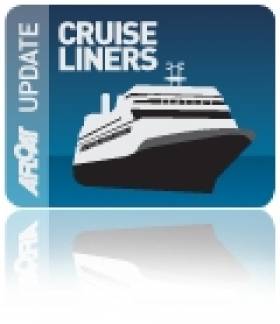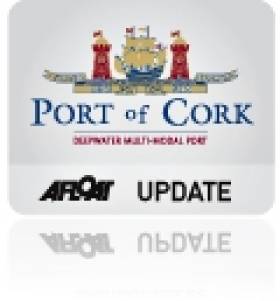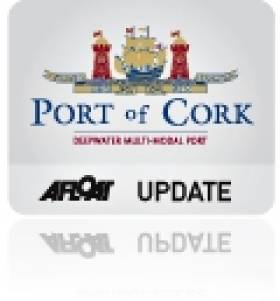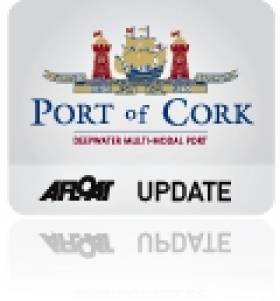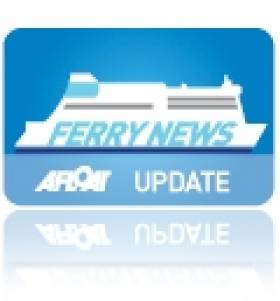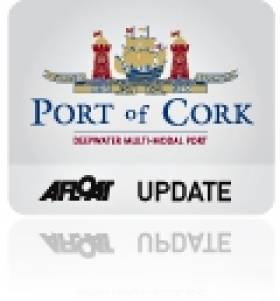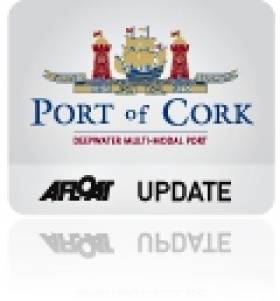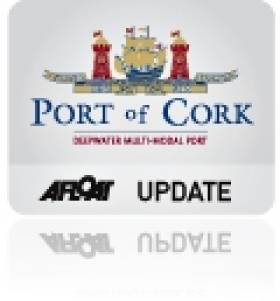Displaying items by tag: port of Cork
A 'Maple' Visitor to Cork
#NavalVisit- While Dublin Port has a flotilla of visiting European naval visitors, the Port of Cork also has a call from a Canadian Navy frigate this weekend, writes Jehan Ashmore.
HMCS St John's (FFH 340) which arrived yesterday to Cork Harbour, is the eleventh of twelve 'Halifax' class frigates and one of the most combat capable warships in the world.
The frigate was commissioned in 1996 in St. John's, Newfoundland and is armed with systems to deal with surface and air threats as well. This combination makes the class the work-horses of the Canadian Navy task group concept.
Listed below are some principle specifications of the Halifax class frigates.
Speed: 29+ knots
Endurance:
7,100 nautical miles at 15 knots (diesel)
4,500 nautical miles at 15 knots (turbine)
Complement: 225 (including air detachment)
Range: 9,500 nautical miles
HMCS St. John's is berthed alongside J.J. Horgan's Wharf on Cork's city's central quays.
In total the Canada Navy has 33 warships, submarines, and coastal defence vessels which are divided more or less evenly between the Atlantic and Pacific coasts.
The naval bases of the Maritime Forces Atlantic (MARLANT) are in Halifax, Nova Scotia and for the Maritime Forces Pacific (MARPAC) this is located in Esquimalt, British Columbia.
Cruise Conference Discusses New Sulphur Emissions Regulations
#CruiseConference- At the Cruise Europe conference held in Le Havre yesterday, plans for the new sulphur emissions regulations due to come into force in 2015 were among the issues discussed at the event.
Captain Michael McCarthy, chair of Cruise Europe and commercial manager at the Port of Cork addressed the potential for fuel shortages when emission control areas (ECAs) come into force in 2015. Citing likely competition between marine and land-based users, he said: "There is a huge shortfall in oil refining in Europe. The European Union may have no choice but to offer derogation by 2015."
McCarthy addressed changes brought about by globalisation of Cruise Lines International Association (CLIA), commenting: "Cruise Europe is happy to sign a Memorandum of Understanding with CLIA Europe to continue to promote consistency of product quality in Europe." For more on this story CruiseandFerry.net reports
Further Discovery as Cork-bound Cruiseship to Launch Season
#CruiseCORK – The first caller of the Cork cruise season is to be made this evening by Discovery, which as previously reported also started the 2013 season to Dublin Port last week, writes Jehan Ashmore.
She is to due to dock around 22.00hrs this evening alongside the deepwater berth at Cobh Cruise Terminal and where she will make an overnight visit.
A total of 60 cruise ships are scheduled to call in 2013, carrying in excess of 100,000 passengers and crew to be welcomed to the region.
Also recently reported on Afloat.ie was the announcement that the Port of Cork Company is to become 'a sister port' in an alliance with PortMiami, the "Cruise Capital of the World".
Close to 700 passengers can be accommodated on Discovery which is making her debut season operating cruises for Cruise & Maritime Voyages. On this cruise she embarked passengers from her homeport of Avonmouth, near Bristol in north Devon.
The UK based CMV are running cruises by the 20,000 tonnes vessel (and Marco Polo) this season. In tandem the owners of Discovery - Voyages of Discovery are marketing their own cruises using the same vessel under the 'Discovery Sailaway' banner.
Considerably larger cruiseships will call throughout the season to Cork Harbour, for further details and dates click this LINER-LIST.
For example the next caller on 27 April is Royal Caribbean Cruise Lines (RCCL) Vision of the Seas, of 78, 000 tonnes with a capacity for more than 2,400 passengers.
Port of Cork & Port Miami Sign 'Sister Seaport Alliance'
#portofcork – Ahead of the busy 2013 cruise season, the Port of Cork today announced details of their sister seaport agreement with PortMiami, the "Cruise Capital of the World". The sister seaport agreement will benefit the Port of Cork and PortMiami in collaborating on the exchange of information and ideas, with the intended aim of increasing both cargo and cruise trade between ports.
The Port of Cork can learn a lot from PortMiami, particularly on increasing the number of cruise calls to Cork. On average Port Miami welcomes 4million cruise passengers annually and has seven cruise terminals, while this year the Port of Cork will welcome 60 cruise liners carrying in excess of 100,000 passengers and crew to the region.
Over the last 10 years, the Port of Cork has invested €8 million in upgrading and improving cruise facilities and this has made a major impact on the number of calls, increasing from 35 in 2005 to 60 this year. The Port of Cork has high aims to grow the number of cruise calls to 80 over the next five years and to increase turn-around calls and overnight stays. Learning from PortMiami and sharing knowledge and industry information will assist the Port of Cork in achieving these goals.
The cruise business in Cork is very important for the local economy and increasing calls and overnight stays will help to generate further revenue for the region.
Other benefits of signing a Sister Seaport agreement for both ports are;
• Commitment to a free and uninhibited exchange of information regarding the cargo and cruise industries in each port, and general marketing research aimed at increasing cruise and cargo traffic between ports.
• Forming groups that exchange security information with the aim of strengthening the safety of ports worldwide
• Assisting in the implementation of educational programs that will help foster goodwill between ports
• Global promotion of both the sister seaport relationship and the advantages of doing business with the sister seaports
While the Port of Cork looks forward to a busy cruise season in 2013, Captain Michael McCarthy Port of Cork Commercial Manager says the sister seaport agreement with Port Miami means a lot for the Port and indeed Cork.
"We attended the largest ever cruise exhibition, Seatrade Miami earlier this year and we were delighted to sign the sister seaport agreement with PortMiami. The benefit of this mutual agreement means we can benchmark our cruise business with PortMiami who have extensive experience in operating cruise terminals. PortMiami is the "Cruise Capital of the World" and they operate very successful turnaround calls for most of the large cruise lines and this is something the Port of Cork hopes to learn from in the future."
Captain McCarthy continued: "In 2012 the Port of Cork had three successful turnaround calls from Royal Caribbean Cruise Line and MSC Cruises and we are aiming to extend this sector of the cruise business."
All cruise vessels that call to Cork are given a very special welcome courtesy of CorkCruise, providing tourist representatives who go on board each vessel, a display of traditional Irish dancing for passengers and a fond farewell on the quayside with a performance by a local brass band. These efforts do not go unnoticed by the passengers and the cruise lines and in 2011 the Port of Cork was awarded two Cruise Insight Awards for 'Best Shore Side Welcome' and 'Best Tour Guides'.
Port of Cork Strategic Development Plan Update
#portofcork – The Port of Cork held a briefing today on the Strategic Development Plan for the port. CEO Brendan Keating outlined the next steps in the plans in terms of public consultation with stakeholders and lodging a planning application with An Bord Pleanala for Ringaskiddy development.
The briefing follows last week's announcement by Minister for Transport Leo Varadkar on a far reaching national Ports policy that identifies the Munster port as one of three 'nationally significant' ports.
The Port recorded a total 9.05 million tonnes in trade traffic at the end of 2012. This is an increase of 2% compared to 2011 figures and it is the first time traffic figures in the port have surpassed 9 million tonnes since 2008.
Cork businessman John Mullins was appointed as Chairman of the Port by the Minister on March 1 (1 March 2013) for a five year term.
The proposed developments are the first phase of the implementation of the Port of Cork's Strategic Development Plan Review (2010), the core principles of which were endorsed in the recently launched National Ports Policy. This Policy has also identified the continued commercial development of the Port of Cork Company as a key strategic objective.
The proposed developments for consideration are an extension to the existing Port of Cork facilities at Ringaskiddy and may comprise of three main elements:
• A container terminal and multi-purpose berth to the east side of Ringaskiddy Basin;
• An extension to the existing deep-water berth and creation of additional cargo storage areas by reclamation to the west side of Ringaskiddy Basin;
• Improvements to the existing road entrance to the Ringaskiddy Deep-water Terminal to provide alternative access to the remainder of the port complex and associated road realignments.
The expanded facilities will facilitate, on a phased basis, the Port of Cork in transferring cargo handling activities from Tivoli and City Quays in due course. This will unlock significant opportunity for sustainable mixed use development in Cork City which is a key objective of the overall CASP Strategy. The Port of Cork is aiming to lodge a planning application with An Bord Pleanala in the third quarter of this year.
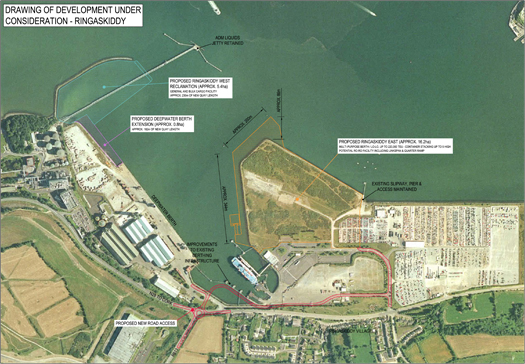
A drawing of the development under consideration at Ringaskiddy. A larger version of this image is available to download below as a pdf document
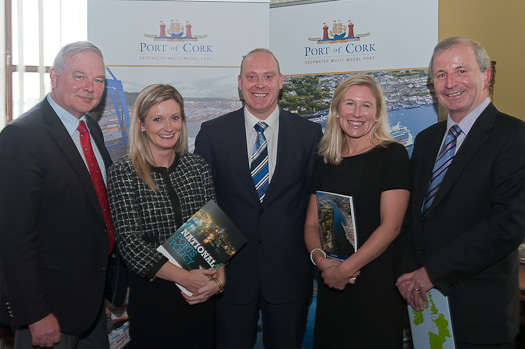
At today's briefing (from left) Brendan Keating, Port of Cork CEO, together with the Port's Sinead Kavanagh, Captain Paul O'Regan, Harbour master, Sara Mackeown and Denis Healy, Engineering Services manager at today's media briefing. Photo: Bob Bateman
Speaking about the proposed developments, Mr Denis Healy, Manager Engineering Services, Port of Cork said: "In order to continue to cater for future growth within the Port of Cork and to provide efficient and cost effective port services for Munster businesses, we are currently engaged in pre-application discussions and would hope to lodge a planning application with An Bord Pleanala in the third quarter of this year."
Mr Healy also outlined the specific drivers for this port development as;
• Current Navigational and Landside Constraints at Tivoli Container Terminal
• Need to Develop a New Deep-water Container Terminal capable of efficiently servicing Larger and Deeper Drafted Vessels
• Overcome Berthing and Landside Capacity Constraints at Ringaskiddy Deep-water Terminal
• Provide Certainty for all Stakeholders that Consolidated Replacement Facilities can be provided.
• Maximise the Utilisation of Existing Port Assets and Locations
• Need for Port to respond to changing Trade and Logistics Dynamics
• Flexibility to Respond to Needs as they arise in a Financially Sustainable Manner
He continued: "The Port of Cork is a key link to the economic success of Ireland, in particular the entire Munster region. 98% of goods imported or exported from Ireland are moved by ship, highlighting the importance of ports to our economy. The Port of Cork must continue to develop the Port in order to meet the needs of the Country in the short, medium and long-term."
The Port of Cork has organised a number of Public Information days to allow interested parties around Cork Harbour to gain an understanding of the port's proposed plans for development, but more importantly to avail the public of an opportunity to give feedback for consideration by the Port.
Dates and venues for the public information days will take place as follows:
• Fota Island Golf Clubhouse - Thursday, 11 April from 4pm – 8pm
• Carrigaline Court Hotel - Friday, 12 April from 2pm – 8pm AND Saturday, 13 April from 10am – 2pm
Port of Cork CEO, Brendan Keating Announced as 'Logistics and Transport Leader' for 2013
#portofcork – Brendan Keating, CEO of the Port of Cork was announced as the winner of the 'Logistics and Transport Leader Award' at the annual Irish Logistics and Transport Awards which took place in the Burlington Hotel, Dublin with over 400 of Ireland's leading transport and logistics professionals in attendance.
Accepting the award, Mr Keating acknowledged the critical value of trade to the Irish economy, with the value of Irish export receipts in 2012 amounting to €177 billion and imports in the same year totalling €13 billion. These figures clearly illustrate the extent of trading activity in Ireland but more importantly show that Ireland is an active player and significant contributor to the process of globalisation of world trade.
Commenting on the significant role that ports play in the supply chain process, Mr Keating remarked "97% of the country's trade in terms of volume transits through our ports so it is critical that port infrastructure in Ireland has the capacity to handle growing volumes of trade. Equally important is ensuring that services provided are competitive while remaining effective and responsive.
"We must ensure that our core ports play an integral role in the delivery of effective supply chain solutions by managing and coordinating the flow of materials, commodities and information" he continued.
While a number of Irish businesses today are focused on driving down supply chain costs, significant risks and vulnerabilities often arise where the sole focus is cost reductions. Brendan Keating concluded by calling on the logistics and transport sector in Ireland to develop a comprehensive risk assessment tool kit which would help manufacturing and other businesses who are heavily reliant on their supply chain for the on-going viability of their business.
Cork-UK Ferry Link ‘Unfeasible’
#CorKWalesFerry – The reinstatement of a ferry link between Cork and the UK is not feasible in the current economic climate, according to a report compiled by transport experts, writes the Irish Examiner.
Cork County Council and the Port of Cork commissioned consultants Strategic Transport Solutions International to undertake a feasibility study of reopening the link after the ill-fated Fastnet Line ceased sailings in 2011.
The report concluded that in the present "economic and competitive climate", a new service cannot be justified commercially on the basis of the volume of passengers and freight achievable in the short term.
Traditionally the main ferry route between Britain and the south-west of Ireland has been Swansea to Cork. However, this time the consultants looked at linking Cork with Newport in Wales, and Bristol in England. To read much more on this story, click here.
Public Consultation On Future Of Bantry Bay Harbour
#IrishHarbours - The Department of Transport, Tourism and Sport (DTTAS) is asking members of the public and all interested parties for their views on plans to merge Bantry Bay Harbour with the Port of Cork Company.
The department believes that the future of Bantry Harbour would best be secured through a merger, and is seeking views on the proposals by 5 April.
Government policy is to merge harbours with significant commercial traffic with a port company, and to transfer smaller harbours to a local authority. To date 11 harbours have transferred to local authority control. Bantry Bay Harbour is now the only regional harbour operating under the Harbours Act of 1946.
A Review of Regional Ports and Harbours in 1999 recommended that Bantry Bay Harbour Authority should merge with the Port of Cork company, on the grounds of good governance.
The core business of Bantry Bay Harbour is the oil storage and transhipment terminal on Whiddy Island. Aquaculture, fishing and tourism are also prevalent in the harbour and a small number of cruise liners visit the harbour each year.
Amalgamation with the Port of Cork would provide access to port expertise, marketing, strategic development planning and the skills required for the regulation of navigation, ship and port security requirements, pilotage, safety, emergency response, and pollution.
The Port of Cork currently provides this professional expertise through the provision of harbourmaster services, on a contractual basis, to bring in large oil tankers and cruise liners into the bay. This is an absolute requirement to operate business in Whiddy to help mitigate the risks of maritime accidents and environmental damage.
Should the transfer take place to the Port of Cork, there is an opportunity for the port to provide local representation to Bantry Bay and some investment back into the harbour. The opportunity also exists for the Port of Cork and the local authority to co-operate with regard to the future development of the harbour.
Port of Cork Appoints New Chairman, John Mullins
#portofcork – Cork businessman John Mullins has been formally appointed as Chairman of the Port of Cork by the Minister of Transport, Tourism and Sport, Leo Varadkar, T.D. today (1 March 2013) and will commence a five year term immediately.
Mullins was most recently Chief Executive of Bord Gáis Eireann, a role which he held for 5 years until he resigned in December 2012 to set up his own consultancy and to pursue other business interests.
Commenting on his appointment, John Mullins said "I am honoured with the trust placed in me by Minister Varadkar. I look forward to my new role as Chairman of the Port of Cork, particularly at
this crucial period for the company as it advances proposals for new infrastructure required to service business for the next twenty years. I strongly believe that the Port of Cork is central to a brighter economic future for the Munster region and the Irish economy as a whole, given the value it brings in moving goods to market for both customers and businesses. As one of Ireland's core ports, I will work to ensure that the Port of Cork continues to grow and improve competitiveness."
Brendan Keating, Chief Executive of the Port of Cork said "John brings extensive experience to his role as Chairman and we are confident that he will provide excellent leadership for the port in the coming years. He will provide valuable assistance with the growth of the business and the development of port facilities as we consolidate our position as the premier port in the South of Ireland".
John Mullins takes over as Port of Cork Chairman from Dermot O'Mahoney, whose term ended in September 2012.
Captain Pat Farnan Retires as Port of Cork Harbour Master
#portofcork – Captain Pat Farnan is to retire as harbour master of the Port of Cork after 33 years with the company.
Captain Farnan joined the Port of Cork in 1980 as Assistant Harbour Master and since then, has built a reputation as one of the leading Harbour Masters in the country. He also served as President of the European Harbour Masters Association from 1996 to 1998.
The Harbour Master is primarily responsible for the safety of all vessels within the port and advises the Board of the Port Company on all nautical matters. In the case of the Port of Cork, he is also responsible for the management of all aspects of port operations, including pilotage, towage and crane operations.
Prior to joining the Port of Cork, Captain Farnan enjoyed a sea-going career with Irish Shipping Ltd, joining as a cadet and subsequently serving in all ranks on a wide variety of vessels, trading worldwide. He left Irish Shipping in 1980 to join the Port, having served as master for two years.
Captain Farnan has also served as Harbour Master of Bantry Bay since 2002.
Captain Farnan lives in Cobh with his wife Carmel and this year celebrates 40 years of marriage. He has two sons, Keith based in Dublin and Patrick based in Cork.
Commenting on his retirement, Captain Farnan said "It has been a privilege to have been the 12th person to hold the position of Harbour Master since 1820.
"I joined the then Harbour Commissioners in 1980 at a particularly fortuitous time as the Port was about to enter an exciting phase of its development with the construction of new facilities at Ringaskiddy. This facilitated the expansion of the Port and in the intervening years the deepwater facilities at Ringaskiddy allowed the Port to accommodate large Panamax vessels and more recently a deep sea container service. Now it is established as one of the leading Ports in the country.
"Among the many highlights for me during my time at the Port of Cork was the return of cruise liners to Cork with the berthing of the QE2 at Ringaskiddy in 1990 and the development of the cruise facilities in Cobh to meet the challenge of the ever increasing size of cruise liner culminating in the berthing of the "Independence of the Seas" and "Queen Mary 2" two of largest cruise ships. The Tall Ships visit in 1991, which was the first time the event was ever hosted in Ireland, was also a great personal highlight of my career.
"One of the major strengths of the Port is the combined efforts of every individual who make the day-to-day running of the Port possible, at all levels and the high level of morale that was maintained over the years. I was fortunate in having a great team supporting me in operations."
Deputy Harbour Master, Captain Paul O'Regan will assume responsibility as Acting Harbour Master and Captain Pat Murphy will be the Acting Deputy Harbour Master. Both will bring their many years of experience and expertise to continue the efficient operations of the Port.
Brendan Keating, Chief Executive of the Port of Cork concluded "Pat has given outstanding service to the Port of Cork and he retires today with our very best wishes."


























